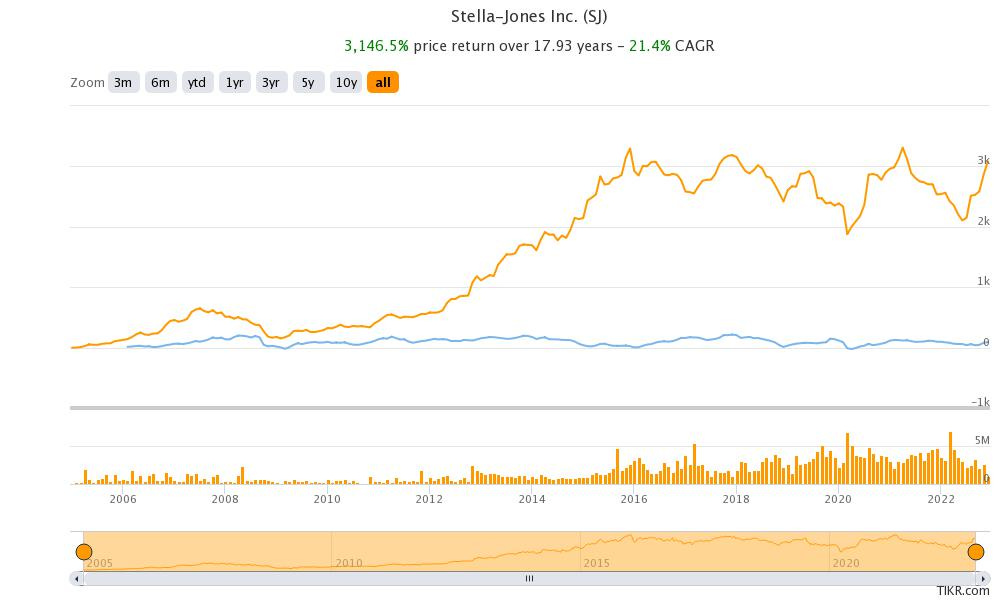Stella-Jones' Moat
As a byproduct of playing around in Journalytic (which I’m loving and suggest you check out) and in honour of $SJ.TO pushing the $50 mark (hopefully on its path to new all-time-highs), I figured I'd write a short post.
I've tweeted a fair bit about $SJ.TO and it's my largest position, so I figured I'd actually post something about it here that I haven’t posted on Twitter.

I tried my hand putting together an actual write up on $SJ.TO - not a bullet point tweet thread - for a VIC application back in June prior to starting this blog. I was denied of course, but the timing of my submission looks pretty good in hindsight! Just 5.6% off of the 52 week low, and now trading at 52 week highs, up around 50% vs flattish gains for the market.
Anyways, that's enough celebrating as the market gods will likely punish me for this intro. Onto the post.
Capital intensive, low margin, slow growth businesses aren't usually what will appear in a quantitative screen for "quality". However, dominant scale/market share and a strong balance sheet within a low margin, low growth, but essential industry, of which operations require significant PP&E, inventory and employee base to operate can be a great combination to result in a moat-y business. $SJ.TO is that kind of business.
Suppose someone had plentiful access to capital and wanted to recreate $SJ.TO. They would need to invest considerably in physical infrastructure and equipment, acquire a bunch of inventory, and hire a sizeable employee base. $SJ.TO has around 2,500 employees, which wouldn't be that easy to come up with in today's environment, and the company has 2.5B between inventory, PP&E, and goodwill (they've made lots of acquisitions) on its Balance Sheet. The cost of the infrastructure required to run the business is most likely understated on the balance sheet due to inflation, so let's just call it a 3B required cash outlay to replicate $SJ.TO's infrastructure and inventory, not to mention that it would be very hard to actually come up with this amount of inventory.
As mentioned, Stella-Jones does not operate in a high-growth industry; a significant majority of its revenues come from maintaining existing infrastructure (replacing railroad ties, power and utility poles, deck boards, ...). So if you were to outlay that kind of money, you'd probably want to be getting a fairly high current earnings yield on that investment. But by replicating Stella-Jones and bringing on new supply into the industry, you'll no doubt disturb industry margins. $SJ.TO typically earns a high single digit net income margin, around 8%, so lets call the margin 5% after the $SJ.TO replication comes into play. On 3B in sales (roughly what $SJ.TO did the TTM), that gets you a 5% earnings yield and ROI on your 3B outlay, and not a fantastic outlook for growth. Seems unlikely to me that someone would spend $3B in this manner.
Alternatively you could try to replicate $SJ.TO through acquisition, rather than from the ground up. However, by rolling up the market outside of $SJ.TO and $KOP, you would still be the #3 player given the extent of the two incumbent's market share. Alternatively, you could acquire $KOP, $SJ.TO’s most notable competitor1 which has a market cap around $650M USD, and has $800M USD in debt. Though to take out $KOP, you'll need to pay a premium, so you're probably looking at $2.2+B CAD based on today’s exchange rate.
Meanwhile, $SJ.TO has a market cap near 3B, has a long track record of better growth, debt isn't an issue, and while $KOP is de-leveraging, $SJ.TO is investing in its business and growing, solidifying its #1 position. Looking at the long-term shareholder return differential between the two companies, it's fair to ask: Why not just buy $SJ.TO?
The above is basically my pitch for why $SJ.TO is in a favorable competitive position; you probably could recreate it if money were no option, but you wouldn’t make much profit in doing so.
I view $SJ.TO as a high quality company with a long lived source of revenues, good pricing power, an ability to grow in the current economic environment, and a sensible capital allocation plan with a strong track record of creating shareholder value.
Despite the recent run up, I still think there’s plenty to like about the stock and continue to view it as a candidate for continued earnings growth and multiple expansion. What would you pay for a series of low growth, inflation protected, long dated cash flows, albeit with some cyclicality?




